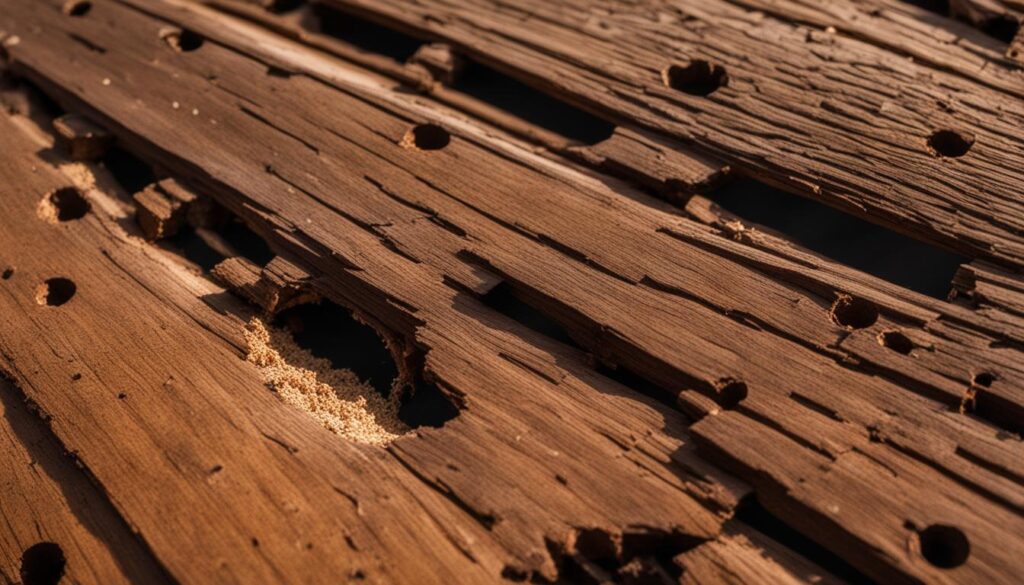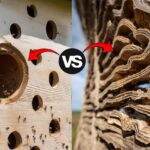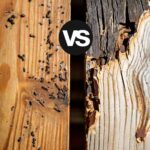Termites, tiny insects known for their ability to cause extensive damage to homes and structures, build mounds primarily in South America, Australia, and Africa using their saliva, feces, and clay. In the United States, termites create nests underground or within wooden structures. There are three main types of termites in the US that homeowners need to be aware of: subterranean termites, formosan termites, and drywood termites. While termite mounds themselves may not pose a direct danger to humans, the presence of termites in a home can lead to significant structural damage and financial loss.
Key Takeaways:
- The three types of termites in the US that cause problems for homeowners are subterranean termites, formosan termites, and drywood termites.
- Termites build nests in the soil and migrate upward to feed on wooden components, causing structural damage.
- Formosan termites are a species of subterranean termites that are known for causing significant structural damage.
- Drywood termites can infest wooden framing, flooring, and furniture.
- It is important to address termite infestations promptly to prevent further damage and seek professional termite control.
While termite mounds themselves may not pose a direct danger to humans, it is essential to be aware of the risks associated with termite infestations and take necessary precautions. Understanding the factors that attract termites and being able to identify signs of termite infestation can help homeowners protect their properties and minimize the potential hazards associated with termite mounds.
Factors that Increase Termite Problems
Termites are a common pest in the United States, and their presence can be a cause of concern for homeowners. Understanding the factors that attract termites and make homes vulnerable to termite attacks is essential for effective termite control and prevention.
Vulnerability to Termite Attacks
There are several factors that can increase the risk of termite infestations in homes. One major vulnerability is existing structural damage. Termites are attracted to weakened or damaged wood, which provides an easy food source for them. Therefore, homes with cracked foundations, damaged components, or deteriorating wooden structures are more susceptible to termite attacks.
Leaky roofs, pipes, or plumbing fixtures can also contribute to termite problems. Termites are attracted to moisture, as it is essential for their survival. Homes with high humidity levels, as well as areas with poor ventilation and excessive moisture, create an ideal environment for termite infestations.
Termite Food Sources
Termites primarily feed on cellulose, which is found in wood and other plant materials. Any house with wooden components, such as structural beams, flooring, or furniture, can be a potential food source for termites. Additionally, termites can infest objects made of cardboard, paper, and even insulation.
Signs of Termite Infestation
Recognizing the signs of a termite infestation is crucial for early detection and prevention of further damage. Some common signs of termite presence include:
- Frass: Termite excrement that looks like tiny wood-colored pellets.
- Mud tubes: Pencil-thin tunnels made by termites to travel between their nest and food sources.
- Discarded insect wings: Termites shed their wings after swarming, leaving behind evidence of their presence.
- Visible tunnels in wood: Termites create tunnels as they burrow through wooden structures.
- Wavy wood surfaces: Termite damage can cause wood surfaces to become uneven or distorted.
- Soft spots or blistering on floors: Infested wooden floors can develop soft spots or show signs of blistering.
- Peeling paint: As termites consume wood, they can cause paint to peel or bubble.
- Loose tiles in bathrooms and kitchens: Moisture-rich areas attract termites, which can loosen tiles over time.

Preventing Termite Infestations
To prevent termite infestations in your home, it is essential to address the factors that attract these pests. Maintaining a dry and well-ventilated environment, fixing any leaks or moisture issues, and ensuring regular inspections for structural damage can help reduce the risk of termite problems. Additionally, using termite-resistant materials during construction or renovation can provide added protection.
If you suspect a termite infestation, it is recommended to seek professional termite control services. Trained technicians can accurately identify the scope of the infestation, develop a targeted treatment plan, and provide ongoing prevention measures to safeguard your home from termite damage.
Termite Mound Construction and Treatment
Termites, known as nature’s architects, are capable of constructing impressive mounds using their saliva, feces, and clay. These mounds serve as intricate indoor habitats for the termites, providing optimal conditions for temperature and moisture regulation. The unique architecture of termite mounds promotes efficient ventilation and airflow, allowing for gas exchange and precise thermoregulation.
Termite mound construction varies in size and design, depending on the termite species and the surrounding environment. Some scientists are studying termite mound structures to gain insights for developing energy-efficient building designs that mimic the natural cooling and heating mechanisms found in these mounds.
When it comes to treating termite mounds, complete demolition is often necessary to eradicate the termite colony and prevent further damage. Professional termite control specialists possess the expertise to assess the situation, identify the type of termites present, and devise a customized treatment plan. Regular termite inspections are crucial to detecting infestations early on, minimizing the risk of structural damage caused by these destructive pests.
By understanding termite mound construction and employing effective treatment methods, homeowners can protect their properties from the devastating consequences of termite infestations. Don’t underestimate the power of these tiny architects; take proactive measures to safeguard your home and ensure its long-lasting strength and integrity.
FAQ
Are termite mounds dangerous?
Termite mounds themselves are not typically dangerous to humans. However, the presence of termites in a home can lead to significant structural damage and financial loss.
What factors increase termite problems?
Homes with existing structural damage, leaks, high humidity levels, or cracks are more attractive to termites. Older homes with damaged components or shifting foundations are also more vulnerable to termite attacks.
What are the signs of termite infestation?
Signs of termite infestation include frass (termite excrement), mud tubes, discarded insect wings, visible tunnels in wood, wavy wood surfaces, soft spots or blistering on floors, peeling paint, and loose tiles in bathrooms and kitchens.
How are termite mounds constructed and treated?
Termite mounds are primarily constructed using termite saliva, feces, and clay. They serve as regulated indoor environments for termites. To treat termite mounds, complete demolition is often necessary to eliminate the termite colony. Professional termite control specialists can assess the situation, identify termites, and create a customized treatment plan.
- How do termite mounds help regulate temperature? - 7 January 2024
- 10 Effective Termite Control Methods That Actually Work - 4 January 2024
- How Long Does It Take for a Termite Mound to Form? - 21 December 2023




